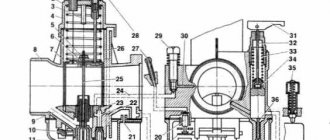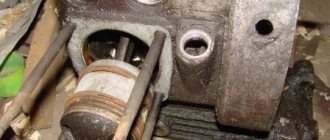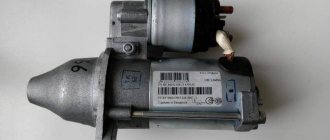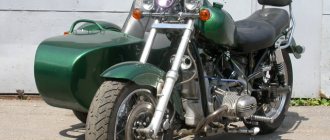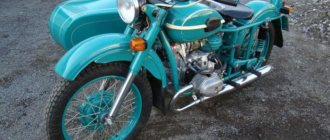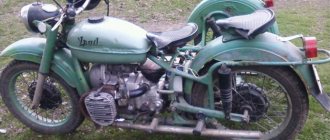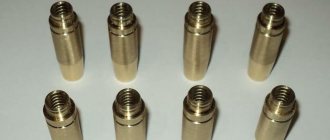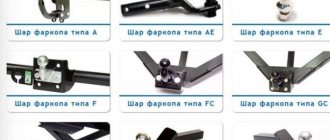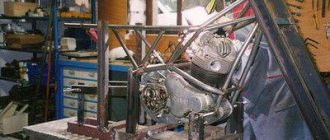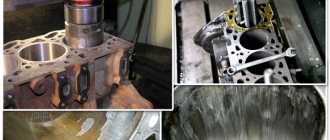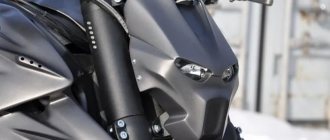Equipping a motorcycle with a starter in most cases is determined by the owner’s desire for convenience and practicality, less often - by urgent need. In some cases, for example, when the technical feature of the unit does not allow it to be equipped with a crank, installing this module is the only way out.
A starter is an electromechanical device designed to start an internal combustion engine. The device is a powerful mixed-excitation electric motor powered by direct current provided by the on-board battery.
About the starter Ural 4320
The more massive the engine, the harder it is to start it.
And especially, diesel engines, like in the Urals 4320. The starter for this car is quite heavy - up to 25 kg. It is a commutator DC electric motor. It contains a gear drive and a bendix to transmit rotation to the engine flywheel. The functioning of the starting device is supported by several relays: a powerful retractor, starter and blocking relay. The retractor sits directly on the starter, and the other two are separate blocks. One of the main characteristics of the Ural 4320 starter is the rotation speed. To start a diesel engine, the crankshaft needs 2-3 revolutions with an amplitude of 130 rpm. The rotational speed of the electric motor intended for the Ural 4320 is 1500 rpm. Due to the action of the drive gear, this high value is normalized and only then transmitted to the flywheel crown.
Other important characteristics:
- supply voltage of the on-board network and, accordingly, the starter - 24 V;
- device power - 6-9 kW, depending on the model;
- current consumption - 130 A (idling) and 800-1000 A (during engine startup);
- Battery capacity is not less than 190 A/h.
Due to the fact that the components of a diesel car starter are subject to heavy loads, the device can last slightly less than the engine itself. The manufacturer himself recommends replacing the starter every 5-6 years.
What is a starter for?
Not all motorcyclists know how to install a starter on a Ural motorcycle. However, almost everyone knows that this can be done to make the use of this type of technology more comfortable.
As you know, a starter is a kind of electric DC motor. In a motorcycle, when installed, it will play the role of the element that will start the engine. Its installation allows you to make engine operation more reliable, and the use of motorcycle equipment will become more pleasant and convenient.
Starters are installed mainly on those motorcycles that have special design features. Basically, such models have frames that do not allow for the placement of a kickstarter pedal. A way out of this situation may be to install a starter. It will make it possible to start the engine.
On motorcycles, Ural rarely sees the absence of a kickstarter. Therefore, the installation of a starter is determined only by the desire of each owner of such motorcycle equipment to somehow improve their motorcycle.
Selection of parts
The best option is electric starters from the Kherson plant, which are used in tractor starting engines, as well as in small-class boat engines. However, you need to be very careful in choosing components - components marked ST353, 367 or 369 are suitable for the Ural. You should not purchase the ST366 starter, which was installed on the Zaporozhets - it has a reverse direction and a different shape of the Bendix casing, incompatible with a motorcycle engine . For such an electric starter, you should purchase a crown from the Buran snowmobile - it requires only minimal modification. Be careful - you need a unit with a top-mounted retractor relay, since, being located at the bottom, it will interfere with changing the oil in the engine.
It is also possible to install an electric starter from a VAZ-2109 car or a more modern unit from a VAZ-2110, but in this case you will have to make the crown yourself, using a professional metalworking machine. To create a spare part, it is better to use steel grade 40-X or another that meets the hardness standard 35-42 HRC/E. For imported motorcycles, the electric starter must be selected especially carefully - many owners of two-wheeled equipment say that components from industrial generators or powerful garden equipment are a suitable option. However, you will definitely have to grind the crown for the starter yourself, since unification is a distinctive feature of domestic motorcycles.
Finishing
When the starter position is set, it must be removed in order to finally weld the flange to the gearbox housing. You can do this yourself, but you will need equipment for argon welding. Make sure all the parts are in place and start working. Remember that after welding the metal must cool on its own, since its forced cooling will lead to a significant decrease in the strength of the joint.
After the metal has cooled, assemble the starter on the flange and make sure that its gear does not move away from the ring even under fairly strong loads on the assembly body. Now you can connect the electric starter to the battery - during operation it should create a monotonous sound, and also rotate the gear without blocking or braking. In addition, it is worth checking how easily it engages and disengages with the crown. Unfortunately, installing an electric starter may interfere with the operation of the engine start pedal. Since it is not advisable to completely remove it, it is better to simply change the shape of the part, while maintaining a backup method of starting the motor.
Source
Features of installing an additional relay on the starter
To install a relay on the starter, you will need:
- wires 1.5 mm2;
- flat female connector - 5 pieces;
- flat male connector - 1 piece;
- 4-pin relay with metal. ear (from 30 to 40 A);
- 2 ring tips for 6 and 8 mm.
Having secured additional relay at a convenient point for you, connect the wiring to the starter. Pull off the red wire from the flat input of the traction relay and insert the “folder” with the wire of the new relay into the connector. Place a wire with an 8 mm tip onto the + terminal and tighten it with a nut. And put the wire from contact 30 with the “female” onto the free contact. Tighten the new and standard wires with a clamp. Then screw the short wire from the new relay to ground. After finishing the work, be sure to hide all the wiring in the corrugation to protect them from moisture.
We install a starter on a Ural motorcycle on our own: it’s as easy as shelling pears
In modern bikes, the starter is installed “by default”, but the Ural bypassed this action. When this bike was first manufactured, this part was unique and considered a luxury, so you had to fork out the cash to afford it. Fortunately, you can install the starter on a Ural motorcycle yourself.
Selection options
An electric starter in the Urals is installed after all the technical characteristics of the vehicle have been determined. Often, car enthusiasts take advantage of the opportunity, if available, and introduce models from a donor car - the VAZ 2109 and its modifications.
You can use a product from other foreign-made machines, but it will cost a little more. When choosing a part, you should also take a closer look at the crown of the device. If the diameter and pitch of the teeth do not meet the requirements, then you need to disassemble the structure of the device and remove the axial shaft with gears. Its teeth are worn down. The diameter expands from the inside so that it can be pressed onto the front side of the ground part. Then they are welded to each other.
Instructions for installing the device yourself
You can find out how to install a starter on a Ural motorcycle below (the author of the video is Absolut Snab).
Required set of tools and materials
- stationery for marking;
- Bulgarian;
- washers, nuts, spokes.
We will find out how to install a starter in the Urals below.
Installation process
Installation of the starter on a Ural motorcycle is carried out at the top of the gearbox. You can install it in the left one, but then you will need to remove the foot or modify the device. First you need to mark a sample of the starter housing and gearbox. After this, using the prepared grinder or machine, cut out the required places on the sample. Fastening can occur in several ways.
Using a plate. It can be purchased at a specialty store or made by yourself
It is important that the plate has a central hole and prepared clamps for attaching to the motor housing. The gearbox mounting spokes need to be replaced with longer ones.
When designing a device with a plate, washers and nuts must be prepared of the appropriate thickness so that when turned on, the Bendix gear is secured to the flywheel ring.
If installation is carried out using a duralumin clamp, which is welded to the gearbox, you need to ensure that deformation does not occur. To do this, you must remove all rubber parts before work.
The plate is welded to the crankcase, previously secured with two pre-prepared nuts
No matter what mounting method is chosen, the load on the plate will be removed by attaching the rear of the product to the outside of the bike. Once it is in place, you need to adjust the necessary gaps
Photo gallery
Price issue
Speaking of price, we can say that modifying this vehicle is quite expensive. Installing the device will cost from 300 to 500 rubles. A new type of crown can be purchased for 2,000 to 3,000 rubles, and an intermediate disk for the crown can be purchased for 1,000 rubles.
We learn how to install a starter on a Ural motorcycle from a video from the Free Riders channel.
Starter fastener
First of all, we determine the place of attachment of the element. The most popular is the upper left side above the flywheel. In this case, we will only be faced with the need to cut out a window for engaging the starter gears. It is difficult to install the starter in the center or on the right side, due to the need to redo a number of engine elements.
For installation, a hole is cut out under the Bendix casing. Next, measurements are taken, and the starter mount is cut out of a 4mm thick sheet of steel. This thickness is necessary to withstand the loads that the fasteners experience during operation of the starter mechanism. In a similar way, you can make not one solid, but a pair of fasteners. This way you can simplify the process of making fasteners, but adjusting the gaps will become much more difficult.
Advice. For greater solidity of the structure, it is best to secure the starter tail rigidly to the motor or grab it with a clamp.
The finished plate is secured with bolts or pinched with argon, then a trial assembly is carried out. Now you need to make sure that the gaps are set:
- the gap between the flywheel gear and the roller clutch is 2-4 mm;
- between the bendix and the crown is 3-7 mm.
Next, the flywheel is rotated, observing the coincidence of the pitch of the bendix and the ring. In this case, rotation of the flywheel is ensured using a kickstarter. Once you are sure that everything is working as expected, you can perform a test turn by unscrewing the spark plugs. If the starter rotates the flywheel without any extraneous sounds, then the plate can be permanently welded with argon.
Important! Welding of the gearbox housing is possible only after dismantling all rubber parts, installing the primary and secondary shafts and securing the cover with 4 bolts.
Electric starter
Well, I finally started writing this post. I’ve long wanted to install an electric starter on my Bolivar, but either I’m not up to it, I don’t want to disassemble the engine, and during the rebuild I want to quickly assemble it and drive it. However, after an unsuccessful trip to Rostov, on the birthday of the Olen bike house, when I turned the crankshaft in Yaroslavl with all the consequences, I decided to finally give myself an electric start during this capital campaign. Despite the fact that the Internet is full of articles on this topic, they are all quite vague, plus I have not seen a single video where a “live” 650cc Ural was started with an electric starter. No, the video is complete, but they show some intermediate stages, like: “here I attached the starter, here I connect the wires to the Akum and it seems like something is turning, but the engine is still half disassembled.” Somehow I got distracted, closer to the topic.
In order to install an electric starter, you need to buy a ring gear for the flywheel. Someone is remaking a crown from Buran (in my opinion), but I took a ready-made one, which is installed instead of the last clutch disc.
Ring gear
Together with the ring gear, a bracket for mounting the starter on the box was purchased. There are two such brackets, on top of the box and on the side. But, since I have a Ural gearbox, and the starter from the side looks, in my opinion, much more aesthetically pleasing, my choice fell on the side mount.
Starter mounting bracket
A tens starter with a 9-tooth Bendix was recommended as a starter. But I had a starter from Oka lying in my garage, which, as it turned out, is almost identical to the ten starter, the only difference is in the starter cover. After going around several auto parts stores, I finally found the cover I needed, so with a slight movement of the hand (and unscrewing a couple of screws) the starter from the Oka was turned into a tenth starter, and at the same time, preventive maintenance was done and the gearbox was lubricated.
Starter from Oka
Difference in starter caps
The starter we need
Then the fun begins. Using the starter mount as a guide, a window is marked on the engine crankcase and gearbox, after which it is roughly cut out (not to size, of course), followed by a file adjustment to the required dimensions.
Example window
After that, only the ring gear was placed on the flywheel, the flywheel was attached to the crankshaft, a mark was made on the crankcase (taking into account that the flywheel would sit deeper) where the ring gear ends and the flywheel begins. A mark was also made on the starter cover where the bendix ends if it is pulled out to the end, after which the flywheel was removed and the holes were adjusted to finish.
Estimation and final hole
The centering bosses had to be cut off from the box housing, otherwise the ring gear would rest against them. I had to disassemble the air filter and cut off part of it so that the starter could fit into place. We also made two box mounting studs, which had to be made larger due to the fact that now the starter was also attached to them.
After that, the flywheel and clutch assembly was finally installed on the crankshaft, the engine and gearbox were assembled, and the starter was roughly put in place. After fitting, there were small tests to see how the starter turns the flywheel, whether the teeth are torn off, whether there is any misalignment, etc.
Starter fitting
First tests
After I was sure that everything was going well, bushings were made to secure the starter at the required distance and at the same time press the box.
Once the starter was finally secured, a second test was carried out to ensure everything was going according to plan.
Second tests
After this, the final stage of engine assembly began. Since there is no air filter now, I temporarily installed zeros. In the future I will install a starter filter from KBMTS.
Final view of the engine
Starter filter
Well, now, actually, the finale. That's what this whole post was all about. Video of starting a Ural 650cc motorcycle using an electric starter. Engine just after rebuild. New crankshaft from Soviet stocks, aluminum cylinders, AT 78mm pistons, new heads. The video shows the second launch. I didn’t film the first launch, but it started up almost immediately, after which I let it run for 10 minutes, turned it off and decided to make this video. Enjoy!
Starting with electric starter
The gearbox housing of the new Urals and the insides of the old one - how realistic is it?
Greetings. It is possible to take a gearbox housing from a modern Ural for a starter. In terms of fasteners and dimensions, the crankcase coincides with the old gearbox. From the photo, I certainly saw some differences in the case. The question is this. How realistic is it to transfer ALL the internals from the Economic Council checkpoint? Will there be any problems? Or is it still more advisable to mutate the starter from the old gearbox?
If I’m not mistaken, the interior from the Economic Council could have been placed in the box from the voyage (the one with direct 4)
I read it somewhere here myself, but in my opinion it was written about shafts. Let's say the shafts can be thrown over, but what about the other mechanisms, about the rear speed? For example, I saw that the kick starter spring starts differently and most likely a different spring is needed, and here is the photo.
the reverse speed on the voyage box can be set by drilling a couple of holes similar to those on the Economic Council, someone did this. and this is a more modern box body; if I’m not mistaken again, you can put dukes in this one. I have the same wolf one.
About six years ago I bought a gearbox housing, the one in the photo. I had a box 8.103.10 with zx. This is what I started from. The shafts stood up as if they were original, a hole was drilled under the gearbox activation mechanism and an oil seal was installed (the boss is ready, you can see it). To secure the gear shift shaft, two bushings were machined - one is simply an aluminum boss, inserted after installing the shaft from the side of the manual gear shift lever. The other is a bracket, a bushing for the shaft diameter with a welded plate with two holes. Above in the photo these holes are highlighted on the lid where the bracket is screwed. For some reason my original gearshift shaft didn’t fit, I don’t remember why. I installed the shaft, it seems, from a box from 72 or 62. The issue with the kickstarter spring has not been resolved to this day. I can't find Wolf's one anywhere. But, theoretically, you can take the Dnieper, stretch it a little and bend one whisker to the side. Minus the kickstarter, the box has been quietly working for several years.
In short, this crankcase is hemorrhoids! Somewhere in the year 09, I got the idea to transfer the offal from the 8.103.10 gearbox into the body of such a box in order to install a starter. I bought this very case and it began. No, I assumed that I would buy the missing parts later. Which one is it! The shift bracket and sector lock are hard to find during the day, not to mention a spring. I swore, I remember! And even now I have an unkind word for IMZ workers who don’t bother to put components for their works on sale. So the case with the back cover lay idle for several years until I sold it this spring.
what is there, besides the kickstarter spring, so crap!? Make a simple bushing and weld it to the plate? Spring yes, bad luck! Indeed, such a “trifle” could be thrown onto the market.
Well, the bracket, whatever, it’s not difficult to make. But look for the sector locking lever together with the spring, there is also a tricky bearing on the gearbox foot - look for it, look for the cover and bushing of the shift axis - look for it or muddy it yourself. Few? Well, maybe, but when I poked my head around all the hot spots selling spare parts in the Urals, they looked at me with round eyes, saying, what are you saying, these spare parts haven’t been around for a long time, what are you talking about?! After this you even feel somehow inferior. And then recently I had to find a valve for 750 Volkov heads. It would seem, what could be simpler? But to hell with it, there is only a kit of American ones with 7 mm. rods at a hefty price and replacing just one (I needed to change 1) would have resulted in hell. Fortunately, they advised me to install it from Dnepr :)
Source
How to install a starter
- First, you need to determine its location in your car. As a rule, it is located at the bottom, at the junction of the gearbox and engine. But in some front-wheel drive models it is more convenient to operate the starter through the hood. It’s worth mentioning separately about Ford cars: here it is not adjacent to the engine and is often located near the battery.
- Before crawling under the car, be sure to block the wheels. Raise the car to the desired height and secure it using strong stands or a support jack.
- Whenever working on the starter, be sure to remove the terminals from the battery.
- To facilitate access, remove the winter corrugation and disconnect the interfering hoses.
- Connect the correct terminals to the new (tested) starter.
- Carefully place the starter in contact with the flywheel.
- Connect the wires to the retractor plug and return the positive terminal to its place.
- Tighten the two upper starter bolts (use a 13 or 15 wrench).
- Climb under the car and screw in the last third bolt.
- Connect the negative terminal.
- Check that all bolts are tight.
- Using a tester, verify the integrity of the wiring insulation.
- Remove the vehicle from a jack or stands.
- When starting the engine, listen for any extraneous sounds during startup. Any interference may indicate that the starter is in contact with the engine or is not engaging.
Installation
There are several options for attaching an electric starter to a boxer motorcycle engine:
- More powerful and longer gearbox studs are made, after which a duralumin plate with a pre-drilled hole with a diameter of 76 mm for the unit casing is put on them. This option is rarely used due to its low strength and negative impact on the service life of the electric starter;
- A composite mount in the form of two crescents is made from duralumin, which is welded from below to the gearbox housing. Be careful - during the argon welding process, all rubber elements of the transmission must be removed, but the shafts and covers should be left in place, since their absence can cause serious deformation of the crankcase;
- A solid duralumin plate is made and welded to the gearbox casing. The bad option is that it forces you to completely remove the contact oil filter, disrupting the normal operation of the transmission.
On foreign motorcycles, installing a starter is complicated by the lack of serious developments in this area. Therefore, you will have to show some engineering savvy and make an appropriate mount or adapter plate that will not interfere with other components.
Before installation, you need to carefully sand the surface of the electric starter stop with a grinding machine to achieve a perfect fit of the part. To properly secure the starter flange, you need to remove the solenoid relay, and also move the bendix fully forward to understand what its operating position will be. The unit is fixed using a flange, after which it is necessary to check the tightness of its fit and the stability of the position. Now you need to set the optimal gaps that will allow you to achieve stable operation of the device.
Between the gear located on the starter and the flywheel ring, you should leave a distance of 5–7 mm - to set it, you can use foil folded many times. You also need to leave a gap of 2–4 mm between the ring and the roller clutch, which is located immediately behind the gear. It should be measured in the rest position, and not in the operating state of the starter, which will allow the unit to achieve stable operation. If you purchased a used starter, make sure that its bronze-graphite bushings are not worn out and also match the diameter of the axle shaft - otherwise the reliability of the part will be significantly reduced, and starting the engine will be accompanied by unpleasant sounds.
Effortless: installing an electric starter on a motorcycle
Starting a motorcycle with a kickstarter can require a lot of effort, which is why many owners of domestic equipment often abandon it in favor of inexpensive foreign analogues. However, Russian motorcycles have their advantages, represented by ease of tuning, low cost of spare parts, as well as low sensitivity to fuel quality and the reliability of most components. That is why experienced owners of two-wheeled domestic vehicles often install an electric starter on a motorcycle - such an operation can make the Ural or Dnepr much more convenient. This also applies to small-capacity budget-class foreign motorcycles, which are also often equipped only with a kickstarter. Let's look at the procedure for installing an electric starter using domestic technology as an example.
Selection of parts
The best option is electric starters from the Kherson plant, which are used in tractor starting engines, as well as in small-class boat engines. However, you need to be very careful in choosing components - components marked ST353, 367 or 369 are suitable for the Ural. You should not purchase the ST366 starter, which was installed on the Zaporozhets - it has a reverse direction and a different shape of the Bendix casing, incompatible with a motorcycle engine . For such an electric starter, you should purchase a crown from the Buran snowmobile - it requires only minimal modification. Be careful - you need a unit with a top-mounted retractor relay, since, being located at the bottom, it will interfere with changing the oil in the engine.
It is also possible to install an electric starter from a VAZ-2109 car or a more modern unit from a VAZ-2110, but in this case you will have to make the crown yourself, using a professional metalworking machine. To create a spare part, it is better to use steel grade 40-X or another that meets the hardness standard 35-42 HRC/E. For imported motorcycles, the electric starter must be selected especially carefully - many owners of two-wheeled equipment say that components from industrial generators or powerful garden equipment are a suitable option. However, you will definitely have to grind the crown for the starter yourself, since unification is a distinctive feature of domestic motorcycles.
Installation
There are several options for attaching an electric starter to a boxer motorcycle engine:
- More powerful and longer gearbox studs are made, after which a duralumin plate with a pre-drilled hole with a diameter of 76 mm for the unit casing is put on them. This option is rarely used due to its low strength and negative impact on the service life of the electric starter;
- A composite mount in the form of two crescents is made from duralumin, which is welded from below to the gearbox housing. Be careful - during the argon welding process, all rubber elements of the transmission must be removed, but the shafts and covers should be left in place, since their absence can cause serious deformation of the crankcase;
- A solid duralumin plate is made and welded to the gearbox casing. The bad option is that it forces you to completely remove the contact oil filter, disrupting the normal operation of the transmission.
On foreign motorcycles, installing a starter is complicated by the lack of serious developments in this area. Therefore, you will have to show some engineering savvy and make an appropriate mount or adapter plate that will not interfere with other components.
Before installation, you need to carefully sand the surface of the electric starter stop with a grinding machine to achieve a perfect fit of the part. To properly secure the starter flange, you need to remove the solenoid relay, and also move the bendix fully forward to understand what its operating position will be. The unit is fixed using a flange, after which it is necessary to check the tightness of its fit and the stability of the position. Now you need to set the optimal gaps that will allow you to achieve stable operation of the device.
Between the gear located on the starter and the flywheel ring, you should leave a distance of 5–7 mm - to set it, you can use foil folded many times. You also need to leave a gap of 2–4 mm between the ring and the roller clutch, which is located immediately behind the gear. It should be measured in the rest position, and not in the operating state of the starter, which will allow the unit to achieve stable operation. If you purchased a used starter, make sure that its bronze-graphite bushings are not worn out and also match the diameter of the axle shaft - otherwise the reliability of the part will be significantly reduced, and starting the engine will be accompanied by unpleasant sounds.
Finishing
When the starter position is set, it must be removed in order to finally weld the flange to the gearbox housing. You can do this yourself, but you will need equipment for argon welding. Make sure all the parts are in place and start working. Remember that after welding the metal must cool on its own, since its forced cooling will lead to a significant decrease in the strength of the joint.
After the metal has cooled, assemble the starter on the flange and make sure that its gear does not move away from the ring even under fairly strong loads on the assembly body. Now you can connect the electric starter to the battery - during operation it should create a monotonous sound, and also rotate the gear without blocking or braking. In addition, it is worth checking how easily it engages and disengages with the crown. Unfortunately, installing an electric starter may interfere with the operation of the engine start pedal. Since it is not advisable to completely remove it, it is better to simply change the shape of the part, while maintaining a backup method of starting the motor.
Additional work
Since the standard electrical system of the Ural motorcycle, as well as the circuit of most imported vehicles, is not designed to operate equipment with a starter, modifications will have to be made to it. At the slightest drop in ambient temperature, starting problems may arise - the starter will quickly discharge the battery, which will force you to recharge it and subsequently use the pedal. Experienced motorcyclists recommend installing a battery from a Japanese car from the 90s on a two-wheeled vehicle. This battery has compact dimensions and a fairly large capacity - up to 65 Ah.
However, installing a large battery will entail another problem - the generator will not be able to charge such a battery completely, and the starter will again be unable to be used. To resolve this issue, you can use the following technical solutions:
- Rewind a standard generator to increase its power by 100-200 watts. However, you need to understand that the reliability of such a node will decrease;
- Installation of a starter is often accompanied by replacing the standard generator with a unit from a light tractor or from a modern model from the Irbit plant;
- To replace the generator with a similar unit from an imported small car from the 90s - parts from Honda and Daihatsu are ideal.
Modifying the electrical network after installing the starter requires a certain amount of professionalism, since if the wires are connected incorrectly or if the insulation is insufficiently wound, you can simply burn the motorcycle.
Since the generator always loses some of its power over time, the starter may stop working again. To avoid such a problem, it is worth cleaning the brushes of the unit every 10 thousand kilometers, adjusting the clearance of its drive mechanism, and also eliminating minor faults. Also, every 5 thousand kilometers, inspect the wiring - if melted areas or breakdowns begin to appear on it, it is worth installing cables with a larger cross-section.
DIY tuning
The starter installation procedure described above requires fairly good skill and special equipment. Therefore, if you do not have an argon welding machine or a lathe, you should find out in advance where you can use the services of professionals of the appropriate profile. All manufactured fastening parts and gears must have minimum tolerances, since the reliability of the installed electric starter depends on this. The starter itself must be in good technical condition - to make sure of this, it is worth checking the bushings and shaft. If all these conditions are met, the electric starter will serve you for many years, providing maximum convenience for starting your motorcycle engine.
www.motoshkoli.ru
How to check the starter retractor relay: video and description
First of all, diagnostic work should begin with checking the starter. To carry out the check, one turn of the key in the ignition is enough. If the device does not work, you will hear characteristic clicks, which confirms that the element is faulty.
Next, you should bridge the contacts, which are represented by two copper bolts located on the relay cover. If the device starts to spin, then most likely the solenoid relay needs to be repaired.
At the same time, another option is also possible. In this case, disconnect the starter
It is important to do everything extremely carefully, because the rotational force of the mechanism is relatively high, so the likelihood of injury is quite high
After completing the dismantling procedure, we place the part on the ground. Using a wire, we connect the contact terminal with the positive one, as well as the ground of the starter with the ground of the battery. After such operations are completed, you should see the relay start up, which is accompanied by a characteristic clicking sound. If the relay activation is not detected, we begin to inspect the contacts - most likely, they are slightly burnt.
Another symptom is a characteristic click from the ignition system, but the starter never starts working. Finally, a sign will also be the mechanism running idle after the key is turned. At the same time, we see that the engine has not started.
If you don't know how to check the operation of the starter relay, the video on our website will help you figure it out. In it you will find a detailed description of how exactly to carry out a comprehensive diagnosis of this unit.
Additional work
Since the standard electrical system of the Ural motorcycle, as well as the circuit of most imported vehicles, is not designed to operate equipment with a starter, modifications will have to be made to it. At the slightest drop in ambient temperature, starting problems may arise - the starter will quickly discharge the battery, which will force you to recharge it and subsequently use the pedal. Experienced motorcyclists recommend installing a battery from a Japanese car from the 90s on a two-wheeled vehicle. This battery has compact dimensions and a fairly large capacity - up to 65 Ah.
However, installing a large battery will entail another problem - the generator will not be able to charge such a battery completely, and the starter will again be unable to be used. To resolve this issue, you can use the following technical solutions:
- Rewind a standard generator to increase its power by 100-200 watts. However, you need to understand that the reliability of such a node will decrease;
- Installation of a starter is often accompanied by replacing the standard generator with a unit from a light tractor or from a modern model from the Irbit plant;
- To replace the generator with a similar unit from an imported small car from the 90s - parts from Honda and Daihatsu are ideal.
Modifying the electrical network after installing the starter requires a certain amount of professionalism, since if the wires are connected incorrectly or if the insulation is insufficiently wound, you can simply burn the motorcycle.
Since the generator always loses some of its power over time, the starter may stop working again. To avoid such a problem, it is worth cleaning the brushes of the unit every 10 thousand kilometers, adjusting the clearance of its drive mechanism, and also eliminating minor faults. Also, every 5 thousand kilometers, inspect the wiring - if melted areas or breakdowns begin to appear on it, it is worth installing cables with a larger cross-section.
DIY tuning
The starter installation procedure described above requires fairly good skill and special equipment. Therefore, if you do not have an argon welding machine or a lathe, you should find out in advance where you can use the services of professionals of the appropriate profile. All manufactured fastening parts and gears must have minimum tolerances, since the reliability of the installed electric starter depends on this. The starter itself must be in good technical condition - to make sure of this, it is worth checking the bushings and shaft. If all these conditions are met, the electric starter will serve you for many years, providing maximum convenience for starting your motorcycle engine.
Installing a starter on a Ural motorcycle with your own hands
Equipping a motorcycle with a starter in most cases is determined by the owner’s desire for convenience and practicality, less often - by urgent need. In some cases, for example, when the technical feature of the unit does not allow it to be equipped with a crank, installing this module is the only way out.
A starter is an electromechanical device designed to start an internal combustion engine. The device is a powerful mixed-excitation electric motor powered by direct current provided by the on-board battery.
Why do you need a starter?
Some models of modern motorcycles are equipped with starters due to the lack of a crank. Here, the presence of a starter is assumed initially. However, in other cases it serves only for the convenience of the rider. There is no need to practice every time before a trip, especially if the valves or ignition are not adjusted.
The Ural, due to its archaic nature, did not even imply the installation of a starter. At the time of the release of the first motorcycles, the starter was a luxury that a Soviet citizen could not afford, and then the design was preserved because of its reliability.
Installing an electric starter on a Ural motorcycle will save you from an overinflated right leg and sudden injuries to the kneecap, so the procedure can be considered as simplifying the life of the rider.
What is the design of the gear-six starter?
The VAZ 2106, produced after the 1980s, has a starter with an end manifold model 35.3708. Earlier cars from the Volzhsky plant had a different gear mechanism installed - ST-221, which was equipped with a cylindrical manifold. Their structure is approximately the same, so they are completely interchangeable.
Let's take a closer look at the design of the mechanisms that interest us, using model 35.3708 as an example. The “six” gear starter consists of the following main parts:
- field winding (i.e. stator) and housing;
- electric drive with anchor;
- three special covers;
- electromagnetic traction relay with two windings (one of them is retracting, the other is holding).
Using bolts, the starter housing is secured into one block with three covers. The armature of the mechanism we are interested in has a core, a commutator and a shaft. The last of these elements rotates in metal-ceramic bushings (there are two of them structurally provided). These bushings are pressed into the covers and must be impregnated with a lubricant. The starter drive is located at the end of the shaft. It includes a gear and a roller clutch, which is necessary to transmit torque to the flywheel.
On the front cover there is a relay consisting of a yoke, several flanges and a core. When the gear mechanism is turned on, two processes occur simultaneously: the armature is retracted, and the drive and gear mesh with the flywheel; a special contact plate closes the bolts. The result of these processes is the start of power supply to the windings of the device we are considering. As you can see, the circuit for switching on and operating the “six” starter is quite simple.
Installation process
Assembly drawing of the electric start system:
- starter mounting part;
- crown;
- starter;
- clamp;
- starter rear mounting bracket;
- flywheel.
Do-it-yourself installation of the starter on a Ural motorcycle is done at the gearbox (often in the upper part). Installation can also be done on the left side , but in this case you will have to sacrifice the kick starter foot, or reconsider its design.
The first step is to mark the sample of the starter housing and gearbox. Then cut out the marked areas using a grinder or milling machine. Among the possible options for mounting the starter, the three most popular are:
- Using a solid steel or duralumin plate. Purchased or made independently, it must have a central hole and fastenings to the engine housing. The standard gearbox fixing spokes are replaced with elongated ones. When installing a starting device with a plate, washers and nuts should be selected of such thickness that when turned on, the bendex gear fully engages with the flywheel ring and similarly comes out of the clutch when turned off.
- Using two separate or one continuous (semi-monthly) lower duralumin clamp welded to the gearbox. In this case, to avoid deformation, all rubber parts from the gearbox housing must be removed.
- A solid duralumin plate is secured with 2 bolts and welded to the gearbox housing.
With any of these types of fastening, the load on the connecting plate is removed by fixing the rear of the starter to the motorcycle body. Next, with the device attached, the gaps are set for both the roller clutch with the ring and the ring with the starter gear.
How to install a STARTER on the URAL/DNEPR with your own hands? Motorcycle repair Ural #31
Video text
Installing the starter took me quite a long time, firstly, because I was doing it for the first time, and secondly, this process is not at all simple and requires some skill. If you are also planning to install a starter on your Ural or Dnepr motorcycle, then this video, I think, will help you see some solutions, and will also help you avoid some of the mistakes that happened to me.
What do you even need?
Well, first of all, it's the starter itself.
I bought it from Pramo-Electro, which is a little more expensive than its counterparts, but has a more compact size, which allows it to look harmonious on a motorcycle, and also, importantly, does not require bending the kickstarter lever. Secondly, you need to purchase a special mounting plate and a starter ring, which is installed instead of the last clutch disc
I purchased this set - plate and crown - from Ivan 66 (https://vk.com/motorazborperm)
But as always happens, you can’t just go and install a starter on a Ural motorcycle. I started by giving my original Ural flywheel to a turner so that he would align all the fingers horizontally, grind off 2-3 mm of the flywheel skirt and reduce the diameter of the intermediate clutch disc so that it would begin to fit into the starter ring.
After modifying the flywheel, I decided to try to assemble a clutch in this flywheel and it turned out that the holes in the flywheel pins and the holes for the countersunk bolts did not match - sad thing. I had to widen the holes on the starter ring. Having allocated one evening for this, we managed to fit everything and the crown was securely attached to the flywheel.
I put the flywheel with the starter ring installed in its place on the crankshaft and tried to figure out the gearbox housing, but I was unable to do this. The reason for this turned out to be special centering bosses on the gearbox, which began to rest against the teeth of the starter ring. The grinder is in hand and the hot flashes at the checkpoint are gone))) Now the checkpoint is working great.
It was decided to replace the gearbox mounting studs with bolts, simply because the length of the original studs is not enough to install the starter.
Finally, I’m starting to install the starter, or more precisely, I’m starting to cut the gearbox housing so that this starter can fit there. I applied the plate to the place where the starter should be located and cut the corresponding hole in the gearbox. Now the starter fits in without problems, but does not fit tightly to the plate, since the starter rests its body against the gearbox mounting bolt. I can’t do without this bolt, so I decided to replace it with an internal hexagon bolt, and make a hole in the starter housing for it. We sorted out the checkpoint.
Next, I decided to cut a suitable hole in the crankcase, but noticed that the starter would completely block the technological hole for setting TDC. But I wouldn’t want to lose it completely. Then I made exactly the same hole on the other side of the crankcase and set the top dead center value on the flywheel. Now nothing will stop me from cutting a hole in the crankcase for the starter.
The hole has been cut out. And then a very timely thought comes to my mind: how to set the engagement gap between the bendix and the starter ring? It is impossible to do this with the gearbox installed, since it blocks the entire view. Then I decided to measure the distance from the starter plate to the edge of the crankcase. In both the upper and lower mounts the distance was 26mm. Now I’ll dismantle the gearbox and simply hang the starter on the bolts, placing it in exactly the same way as with the gearbox, i.e. at a distance of 26mm from the crankcase.
After connecting the battery, the starter began to turn the Ural engine. And in my opinion, it’s very good!))) No unnecessary noise or ringing can be heard.
I hope that the starter will only please me on my journey.
Excellent crankshaft oil seal for the rear cover of a Ural motorcycle. Manufacturer: Toyota. Japan. Catalog number: 90310-50006. Average price in stores: 350 rub.
_____________________________ ABOUT THE CHANNEL “SANYA CHETODEL”
As you might guess, they called me that because I am constantly doing something. I really love working and creating things with my own hands. At the same time, I constantly force myself to learn something new and unknown. For example, in these videos I am repairing an old Ural motorcycle, on which, based on the results of the repair, I plan to go on a trip to Crimea. This motorcycle will not only receive a complete overhaul, but will also undergo some tuning. I talk in detail about everything I do with the motorcycle in the playlist “Ural Motorcycle Repair”
Battery and alternator problems
After installing the starter on a Ural motorcycle with your own hands is completed, a couple of unresolved problems remain. First of all, a car starter requires a more powerful battery. The way out of the situation is to install an inexpensive battery on a new mount (from the side of the motorcycle. Everything will look quite rough, but it’s inexpensive.
Another way is to select an imported battery of a similar size with an increased capacity of 18 A/h. You will have to overpay quite a bit, but the appearance of the motorcycle will not suffer.
Finally, it turns out that the original generator is rather weak and is unable to charge a new battery. We’ll answer right away that rewinding will help increase productivity, but it will not be enough for our purposes. What should we do then? There are several options:
Selecting the ring gear and starter
First of all, we pay attention to the flywheel of the motor, it is the key for further work. Its rotation, when viewed from the gearbox, occurs counterclockwise, which means you need to select a starter that rotates in the opposite direction (clockwise)
Here are the models that suit us:
- ST 353;
- ST 367;
- ST 369;
- From VAZ 2110 (21011);
It is also possible to install a starter in the Urals from a number of models suitable for imported cars. The problem with such starters is their high cost, which also applies to modern VAZ car models. Here, choose for yourself what is your priority - the cost of the part or the service life.
Pay attention to the presence of the casing and its orientation. The method of fastening the part and further ease of maintenance will depend on this parameter.
Rotating the starter relative to its own axis is not advisable and can lead to its breakdown.
Now you need to pick up the crown. The crown is a gear lining on the flywheel that transmits the rotation of the starter to the engine through a gear transmission. The problem is that purchasing the part is quite problematic. A spare part from the Buran snowmobile, as well as more modern domestic motorcycles “Voyage”, “Cobra”, “Wolf” can be suitable for the size of the flywheel. The size of the teeth of the first ring is 2.5, and the modulus of the last three is 2.2. This parameter must be related to the starter module.
If the modules do not match, there are several options to solve the problem:
- We change the starter ring/gear to one that matches the module.
- We adjust the teeth of the existing starter ring or gear to the module.
- We make the starter ring or drive gear from scratch.
Choosing a starter
Before installing an electric starter on a Ural motorcycle, you should familiarize yourself with the technical parameters of the motor of this vehicle. The latest models of the two-wheeled legend are equipped with a four-stroke flat-twin engine with a displacement of 745 cm3 and a power of 40 hp.
For installation, both on the specified engine and on other creations of IMZ and KMZ, models ST-353, ST-367, ST-369 or “donor” ones from VAZ 2109, 21099, 2110 and 21011 are most often used. Their characteristic feature is rotation of the drive clockwise, widespread and low cost. This component can also be taken from foreign cars (Skoda, Mitsubishi, Toyota, etc.), but due to the relative high cost, their use is less common.
You should also pay attention to the crown of the device. If its diameter or tooth pitch differs from what we need, then this part must be modified. Its implementation is achieved by disassembling the starter and removing the axial shaft with the gear attached to it. The teeth of the latter are ground off, while the inner part remains intact. The inside diameter of a suitable gear is bored enough so that it can be pressed onto the outside of the ground part. After pressing, both components are welded, and the seams are ground together.
Typical faults
Obviously, malfunctions occur on the most loaded elements of the starting device - the drive and the electrical component. For example, problems often occur in the starter armature:
- it rotates at low speed because it becomes dirty, or the contacts in the brush assembly (also the solenoid relay) burn out - in this case, the current strength should be less than normal;
- if the current strength is higher than normal, then the armature can rotate slowly due to breakdown of the winding and various mechanical damage - rotor misalignment, drying out of lubricant, wear;
- the armature does not spin at all, and the current strength is less than the standard value - there is a break in the circuit, it is also possible that the wiring of the solenoid relay is broken;
- if the rotor does not rotate, but the amperage is normal, there is a breakdown to ground.
Other common types of problems encountered with the 4320 starter include:
- the brush assembly is triggered, so the electric motor rotates, but the motor does not start;
- contacts oxidize or the flexible mass is damaged, which leads to the starter clicking without rotation;
- the bendix teeth grind off, which is why the starter is unable to grasp the flywheel, although it works;
- The solenoid relay deteriorates, so the starter continues to rotate even after starting the internal combustion engine - short circuits, burnt contacts and other troubles are also possible.
Before removing the electric motor, it is recommended to carefully check the operation of the battery, the condition of its terminals, as well as the amount and condition of the oil in the engine. You should know that powerful diesel engine starters have one feature - often problems arise one after another, like an avalanche. For example, excessive load on the device leads to overheating of the winding and then short-circuiting the insulation. At the same time, the bushings begin to wear out rapidly, the rotor shaft breaks, the drive and even the flywheel crown are damaged. If the operation of the power circuit is disrupted, this leads to the starter losing its power, and an excessively high current literally burns out the brush assembly and armature commutator due to breakdown.
